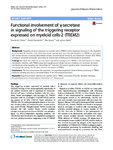Functional involvement of γ-secretase in signaling of the triggering receptor expressed on myeloid cells-2 (TREM2)
| dc.contributor.author | Glebov, Konstantin | |
| dc.contributor.author | Wunderlich, P | |
| dc.contributor.author | Karaca, I | |
| dc.contributor.author | Walter, J | |
| dc.date.accessioned | 2019-01-30T12:49:21Z | |
| dc.date.available | 2019-01-30T12:49:21Z | |
| dc.date.issued | 2016-12 | |
| dc.identifier.issn | 1742-2094 | |
| dc.identifier.issn | 1742-2094 | |
| dc.identifier.other | 17 | |
| dc.identifier.uri | http://hdl.handle.net/10026.1/13239 | |
| dc.description.abstract |
BACKGROUND: Triggering receptor expressed on myeloid cells-2 (TREM2) exerts important functions in the regulation of monocytes, like dendritic cells, osteoclasts, tissue macrophages, and microglia. Mutations in TREM2 are associated with several diseases, including Nasu-Hakola disease, frontotemporal dementia, and Alzheimer's disease (AD). TREM2 undergoes sequential proteolytic processing by ectodomain shedding and intramembrane proteolysis. FINDINGS: We show that inhibition of γ-secretase-dependent cleavage of the TREM2 C-terminal fragment in cellular membranes interferes with TREM2-dependent signaling and cellular function. Inhibition of γ-secretase decreases membrane-proximal signaling and intracellular Ca(2+) response. Decreased signaling alters morphological changes and phagocytic activity of cells upon selective stimulation of TREM2. CONCLUSIONS: The data demonstrate the importance of γ-secretase-dependent intramembrane processing in TREM2-mediated signaling and, thus, a functional relation of two AD-associated proteins. | |
| dc.format.extent | 17- | |
| dc.format.medium | Electronic | |
| dc.language | en | |
| dc.language.iso | eng | |
| dc.publisher | Springer Science and Business Media LLC | |
| dc.subject | Triggering receptor expressed on myeloid cells-2 | |
| dc.subject | TREM2 | |
| dc.subject | gamma-Secretase | |
| dc.subject | Presenilin | |
| dc.subject | Receptor shedding | |
| dc.subject | Phosphatidylinositol-4,5-bisphosphate | |
| dc.subject | Intracellular Ca2+ | |
| dc.subject | Phagocytosis | |
| dc.title | Functional involvement of γ-secretase in signaling of the triggering receptor expressed on myeloid cells-2 (TREM2) | |
| dc.type | journal-article | |
| dc.type | Journal Article | |
| dc.type | Research Support, Non-U.S. Gov't | |
| plymouth.author-url | https://www.webofscience.com/api/gateway?GWVersion=2&SrcApp=PARTNER_APP&SrcAuth=LinksAMR&KeyUT=WOS:000368417900003&DestLinkType=FullRecord&DestApp=ALL_WOS&UsrCustomerID=11bb513d99f797142bcfeffcc58ea008 | |
| plymouth.issue | 1 | |
| plymouth.volume | 13 | |
| plymouth.publication-status | Published | |
| plymouth.journal | Journal of Neuroinflammation | |
| dc.identifier.doi | 10.1186/s12974-016-0479-9 | |
| plymouth.organisational-group | /Plymouth | |
| plymouth.organisational-group | /Plymouth/Faculty of Health | |
| plymouth.organisational-group | /Plymouth/Faculty of Health/Peninsula Medical School | |
| plymouth.organisational-group | /Plymouth/REF 2021 Researchers by UoA | |
| plymouth.organisational-group | /Plymouth/REF 2021 Researchers by UoA/UoA01 Clinical Medicine | |
| plymouth.organisational-group | /Plymouth/Users by role | |
| plymouth.organisational-group | /Plymouth/Users by role/Academics | |
| dc.publisher.place | England | |
| dcterms.dateAccepted | 2016-01-11 | |
| dc.identifier.eissn | 1742-2094 | |
| dc.rights.embargoperiod | Not known | |
| rioxxterms.versionofrecord | 10.1186/s12974-016-0479-9 | |
| rioxxterms.licenseref.uri | http://www.rioxx.net/licenses/all-rights-reserved | |
| rioxxterms.licenseref.startdate | 2016-01-20 | |
| rioxxterms.type | Journal Article/Review |


